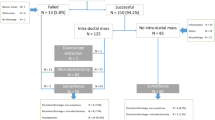Abstract
Background
Pathologic nipple discharge (PND) is diagnosed clinically and managed by diagnostic duct excision (DDE). Mammary ductoscopy in the office setting may change this standard. We performed a prospective study to assess the utility of office ductoscopy for surgical selection in women with nipple discharge.
Methods
Women with nipple discharge meeting at least 2 of 3 criteria of PND (spontaneous, single duct, bloody or serous) underwent office ductoscopy. Those showing papillomatous lesions underwent DDE in the operating room (surgical group, n = 38); if no lesion was present, women were followed clinically (observation group, n = 21).
Results
A papillomatous lesion was identified in 79% of women with 3-criteria PND and in 21% with 2 criteria (P = .001). DDE yielded a proliferative lesion in 35 of 38 women (92%). Of the 38, 27 (71%) had papillomata, 2 (5%) had florid hyperplasia, and 6 (16%) had ductal carcinoma in situ (DCIS) on final pathology. Also, 11 women with papilloma and 1 with DCIS presented with 2-criteria PND. Ductoscopy findings were a better predictor of the presence of intraductal neoplasia (area under curve [AUC] 0.9, 95% confidence interval [95% CI] 0.8–0.98) compared with 3-criteria PND (AUC 0.7, 95% CI 0.6–0.8). The 21 women in the observation group did not develop signs of malignancy or need biopsy during a 48-month follow-up period.
Conclusions
Our findings suggest that office ductoscopy provides accurate surgical selection of women with nipple discharge and should be considered for women with 2 criteria of PND, and those with negative ductoscopy can be safely observed. These findings need confirmation in a larger study with longer follow-up.

Similar content being viewed by others
References
Dawes LG, Bowen C, Venta LA, Morrow M. Ductography for nipple discharge: no replacement for ductal excision. Surgery. 1998;124:685–91.
Simmons R, Adamovich T, Brennan M, Christos P, Schultz M, Eisen C, et al. Nonsurgical evaluation of pathologic nipple discharge. Ann Surg Oncol. 2003;10:113–6.
Morrogh M, Morris EA, Liberman L, Borgen PI, King TA. The predictive value of ductography and magnetic resonance imaging in the management of nipple discharge. Ann Surg Oncol. 2007;14:3369–77.
Morrogh M, Park A, Elkin EB, King TA. Lessons learned from 416 cases of nipple discharge of the breast. Am J Surg. 2010;200:73–80.
Kapenhas-Valdes E, Feldman SM, Cohen JM, Boolbol SK. Mammary ductoscopy for evaluation of nipple discharge. Ann Surg Oncol. 2008;15:2720–7.
Dietz JR, Crowe JP, Grundfest S, Arrigain S, Kim JA, et al. Directed duct excision by using mammary ductoscopy in patients with pathologic nipple discharge. Surgery. 2002;132:582–7.
Hunerbein M, Estevez SL, Schneider U, Schlag PM. Evaluation of pathologic nipple discharge with ductoscopy. J Am Coll Surg. 2003;197:697–8.
Moncrief RM, Nayar R, Diaz LK, Staradub VL, Morrow M, Khan SA. A comparison of ductoscopy-guided and conventional surgical excision in women with spontaneous nipple discharge. Ann Surg. 2005;241:575–81.
Liu GY, Lu JS, Shen KW, Love S, Zhang JX, Xu XL, et al. Fiberoptic ductoscopy combined with cytology testing in the patients of spontaneous nipple discharge. Breast Cancer Res Treat. 2008;108:271–7.
Sharma R, Dietz J, Wright H, Crowe J, DiNunzio A, Woletz J, et al. Comparative analysis of minimally invasive microductectomy versus major duct excision in patients with pathologic nipple discharge. Surgery. 2005;138:591–6.
Montroni I, Santini D, Zucchini G, Fiacchi M, Zanotti S, Ugolini G, et al. Nipple discharge: is its significance as a risk factor for breast cancer fully understood? Observational study including 915 consecutive patients who underwent selective duct excision. Breast Cancer Res Treat. 2010;123:895–900.
Gray RJ, Pockaj BA, Karstaedt PJ. Navigating murky waters: a modern treatment algorithm for nipple discharge. Am J Surg. 2007;194:850–4.
Gioffre’ Florio MA, Manganero T, Pollicino A, Scarfo P, Micali B. Surgical approach to nipple discharge: a ten year experience. J Surg Oncol. 1999;71:235–8.
Cabioglu N, Hunt KK, Singletary SE, Stephens TW, Marcy S, Meric F, et al. Surgical decision making and factors determining a diagnosis of breast carcinoma in women presenting with nipple discharge. J Am Coll Surg. 2003;196:354–64.
Tang SS, Twelves DJ, Isacke CM, Gui GP. Mammary ductoscopy in the current management of breast disease. Surg Endosc. 2010 [Epub ahead of print].
Vaughan A, Crowe JP, Brainard J, Dawson A, Kim J, Dietz JR. Mammary ductoscopy and ductal washings for the evaluation of patients with pathologic nipple discharge. Breast J. 2009;15:254–60.
Louie LD, Crowe JP, Dawson AE, Lee KB, Baynes DL, Dowdy T, et al. Identification of breast cancer in patients with pathologic nipple discharge: does ductoscopy predict malignancy? Am J Surg. 2006;192:530–3.
Kapenhas-Valdes E, Feldman SM, Boolbol SK. The role of mammary ductoscopy in breast cancer: a review of the literature. Ann Surg Oncol. 2008;15:3350–60.
Sarakbi WA, Escobar PF, Mokbel K. The potential role of breast ductoscopy in breast cancer screening. Int J Fertil Womens Med. 2005;50:208–11.
Kamali S, Bender O, Aydin MT, Yuney E, Kamali G. Ductoscopy in the evaluation and management of nipple discharge. Ann Surg Oncol. 2010;17:778–83.
Denewer A, El-Etribi K, Nada N, El-Metwally M. The role and limitations of mammary ductoscope in management of pathologic nipple discharge. Breast J. 2008;14:442–9.
Grunwald S, Heyer H, Paepke S, Schwesinger G, Schimming A, Hahn M, et al. Diagnostic value of ductoscopy in the diagnosis of nipple discharge and intraductal proliferations in comparison to standard methods. Onkologie. 2007;30:243–8.
Sauter ER, Shan S, Hewett JE, Speckman P, Du Bois GC. Proteomic analysis of nipple aspirate fluid using SELDI-TOF-MS. Int J Cancer. 2005;114:791–6.
Fackler MJ, Rivers A, Teo WW, Mangat A, Taylor E, Zhang Z, et al. Hypermethylated genes as biomarkers of cancer in women with pathologic nipple discharge. Clin Cancer Res. 2009;15:3802–11.
Author information
Authors and Affiliations
Corresponding author
Rights and permissions
About this article
Cite this article
Khan, S.A., Mangat, A., Rivers, A. et al. Office Ductoscopy for Surgical Selection in Women with Pathologic Nipple Discharge. Ann Surg Oncol 18, 3785–3790 (2011). https://doi.org/10.1245/s10434-011-1791-3
Received:
Published:
Issue Date:
DOI: https://doi.org/10.1245/s10434-011-1791-3




